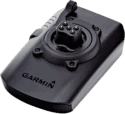Tech
Best Bike GPS 2024 In-Depth: Garmin Edge 840 vs Hammerhead Karoo 3 vs Wahoo ROAM V2
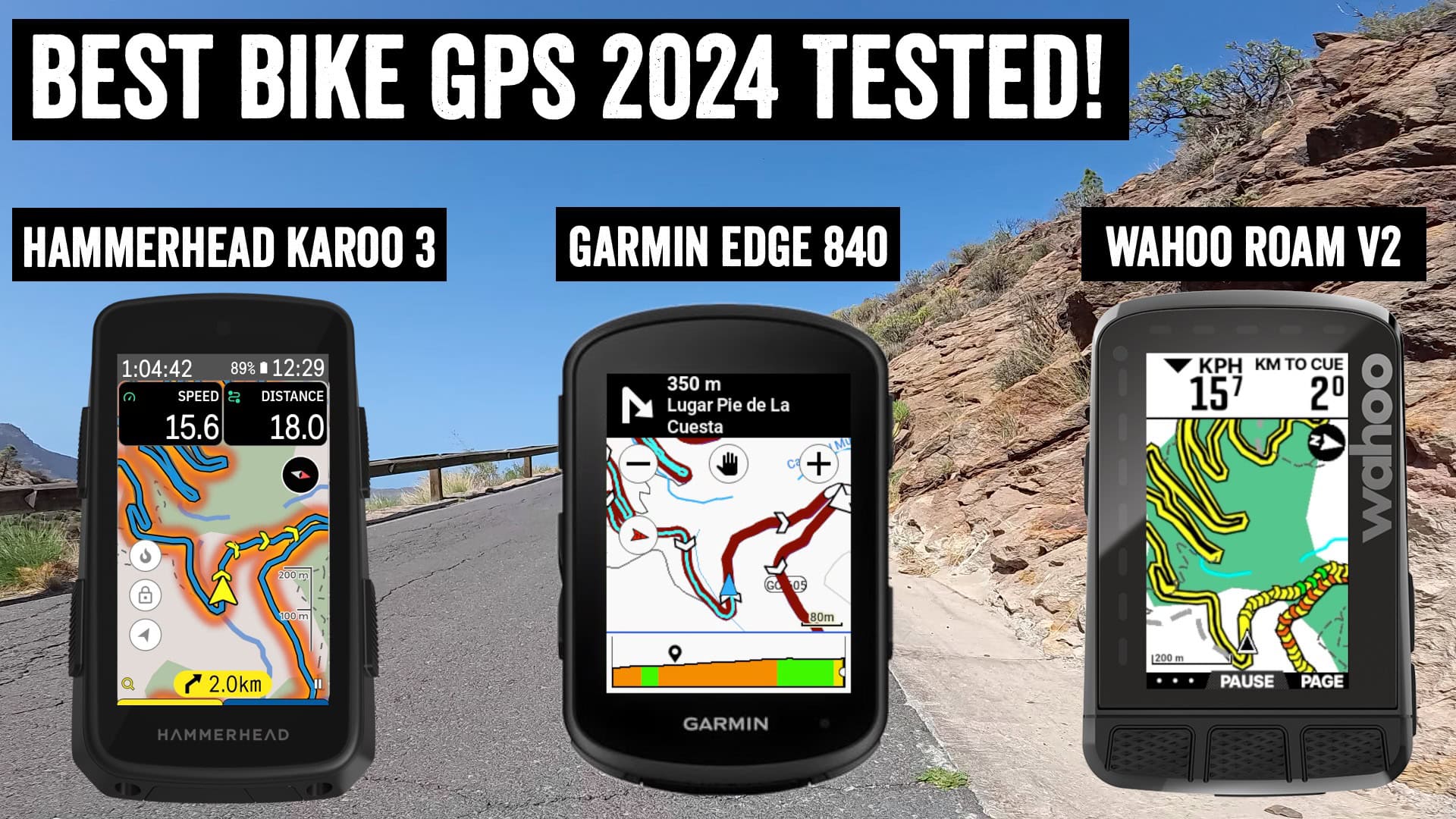
It’s time for another bike computer comparison, this time comparing the best bike computers at the sub-$500 level. The price range is somewhat arbitrary – as really my goal was to compare the three most popular options from the three most popular brands. In this case that matches up the Garmin Edge 840, the new Hammerhead Karoo 3, and the Wahoo ROAM V2.
Sure, there are more expensive units out there, and cheaper units out there. But I’d argue these are the sweet spot of the best available bike tech on the market.
I’ve been using all three of these side by side for quite some time. Roughly 1,000km over the last few months of rides with all three units on the handlebars, comparing them in all manner of conditions. Be it sunny hot days, mountain passes, dumping rains, and more.
I’ll be covering all of the following areas, trying to summarize the key differences for each model.
1. Pricing
2. Included Mounts
3. Display & Screen
4. Usability & Ease of use
5. Data Pages & Data Fields
6. Navigation & Mapping
7. Climbing
8. Structured workouts
9. Strava Live Segments
10. Battery Life
11. Sensor/Connectivity
12. Physiological Metrics (and crash detection), structured workouts, calendar, etc..
13. Web Platform & Phone Apps
14. 3rd Party Apps & Integrations
15. GPS & Elevation Accuracy
Of course, I’ve got in-depth reviews available for all these units as well, which you can find here:
– Garmin Edge 840
– Hammerhead Karoo 3
– Wahoo ROAM V2 In-Depth Review
Note, I’m going to try and keep each section to the most critical 1-3 paragraphs of info. Obviously, I’ll undoubtedly fail at that. But this is partially so things don’t get too out of hand (and I can actually finish this comparison), and partially so that it’ll make this thing consumable. Point is, there are going to be tons of itty-bitty differences I can’t cover without this post being 500 pages long. Feel free to drop questions the comments and I’ll do my best!
Pricing:
This is arguably the easiest of the sections, the retail prices are as follows (for base, non-bundles):
– Garmin Edge 840: $449
– Hammerhead Karoo 3: $479
– Wahoo ROAM V2: $399
Obviously, there are other variants here. The Edge 840 Solar is $549, but unless you live in Florida or something, I don’t see the value of it. More on that in the battery section.
Further, sales can also impact this. Garmin has the Edge 840 on sale for $399 right now, and the Edge 1040 down to $499 right now. This is the first time either has been that low. Equally, Wahoo will occasionally put the ROAM down to $349, though it hasn’t been on sale this year yet. Note that Garmin’s current philosophy is that the Edge 840 & Edge 1040 are feature-wise identical, with the only difference being the screen size.
Included Mounts:
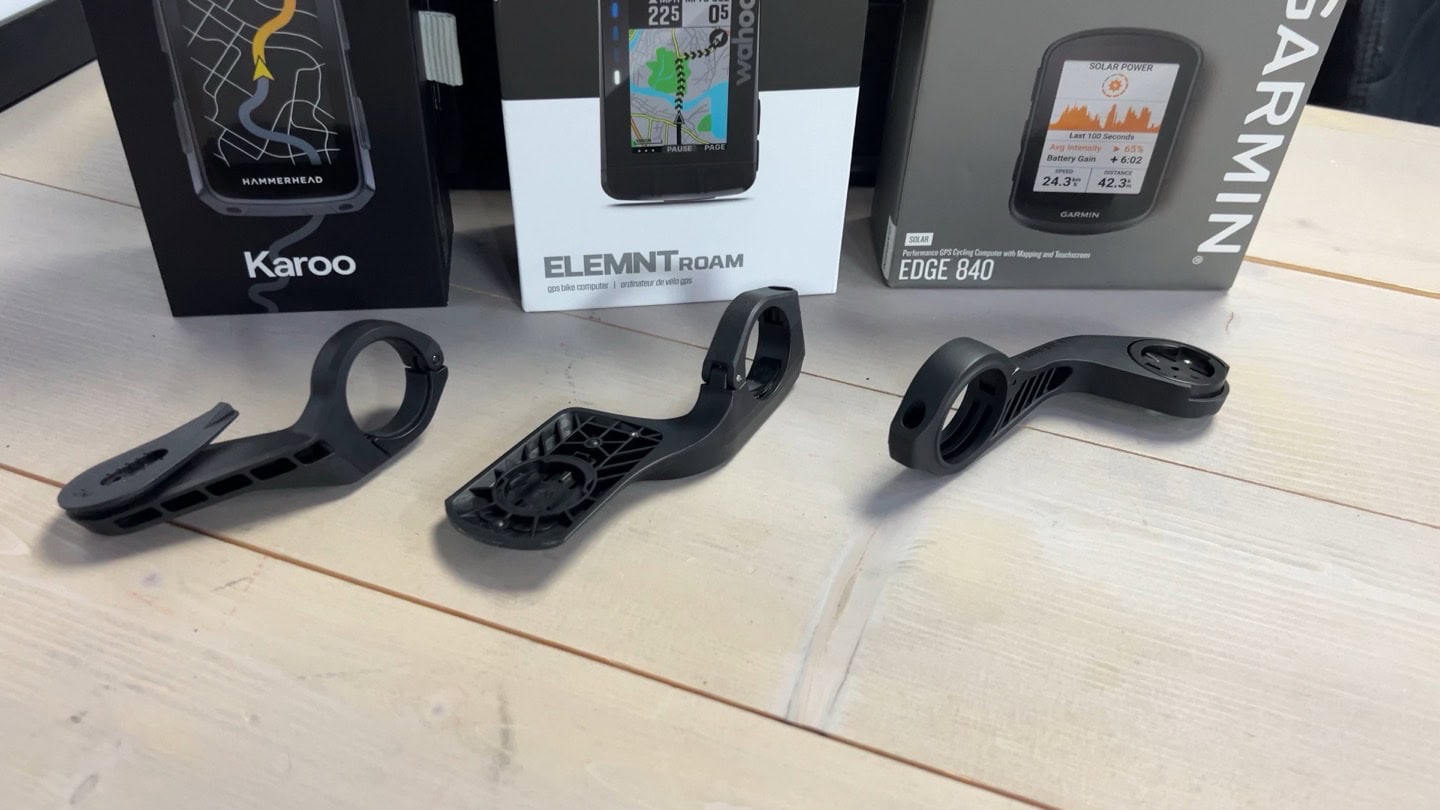
All three units come with included out-front mounts for your handlebars. In the case of Hammerhead and Garmin, these mounts can also support 3rd party lights/GoPro’s being hung below them, if you buy the extra adapter. Wahoo’s mount is an ‘aero mount’ that’s designed to be more aerodynamic, and doesn’t have any connectivity options. Both Garmin & Wahoo also include smaller rubber-band style mounts, handy for extra bikes/traveling.
When it comes to adapting these units to 3rd party mounts, all three have 3rd party mounts from various companies. Garmin obviously has a gazillion options (including bikes with built-in mounts), and Wahoo has plenty from the major players. Hammerhead has a few options, including from SRAM entities and K-Edge. However, both Wahoo & Hammerhead seem to acknowledge this outsized reality. Hammerhead includes a Garmin to Hammerhead adapter in the box, allowing you to use Garmin’s quarter-turn mounts. Whereas Wahoo sells the tiny adapter separately.
Display & Screen
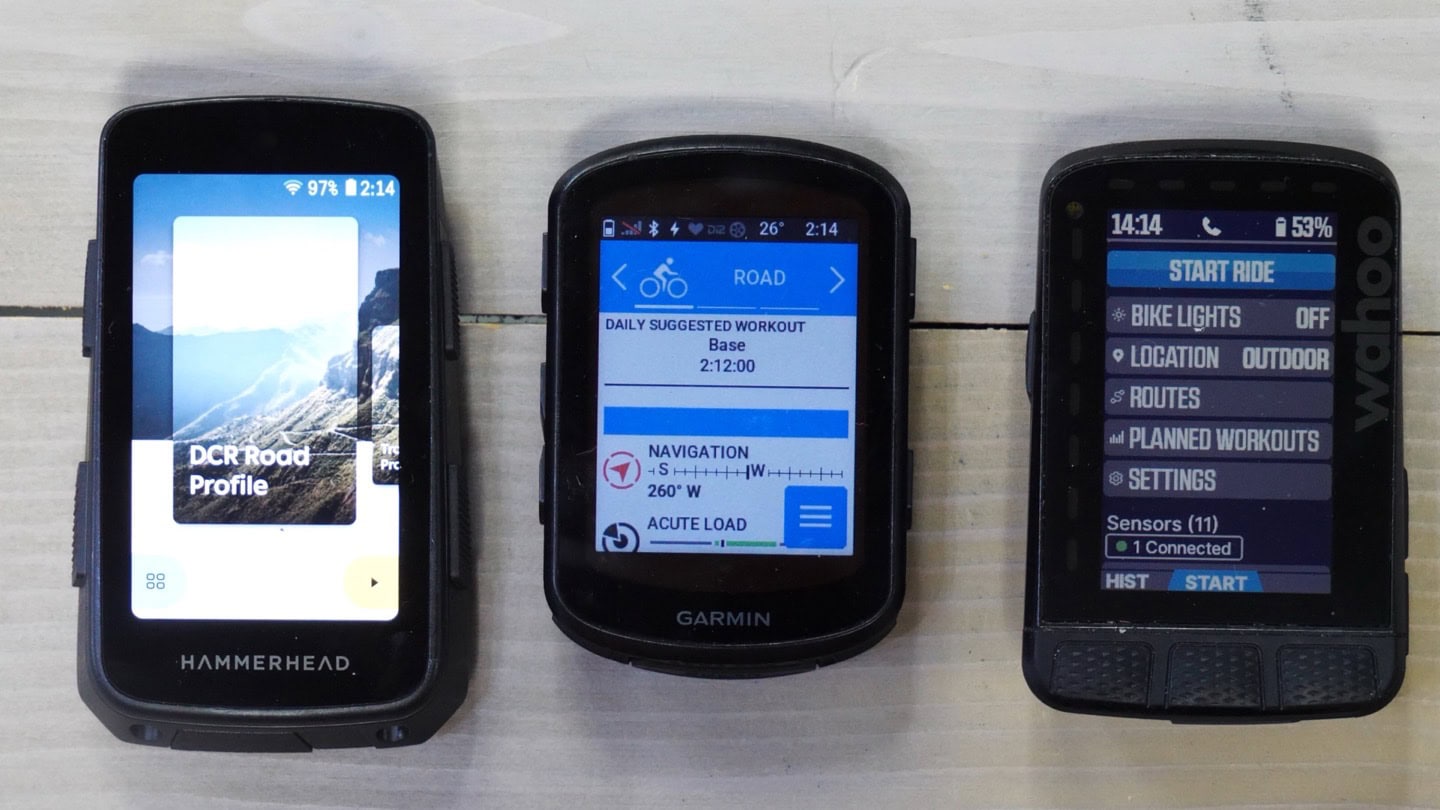
The three companies have relatively similar screen sizes for their units, but with differing resolutions, most notably from the Hammerhead side. Here’s those specs:
Garmin Edge 840: 2.6” display at 246×322 pixels
Hammerhead Karoo 3: 3.5” display at 480×800 pixels
Wahoo ROAM V2: 2.7” display at 240×400 pixels
Arguably, this is the single biggest difference for Hammerhead, and the one I get the most question on. Thus, I may go over my 3-paragraph limit here. Apologies. First, the Karoo 3 is definitely more viewable than the Karoo 2, due to the increased brightness and new top-cover. Equally, and this is *super important*: All there units are totally viewable in all lighting conditions. I’ve done everything from night riding, to thunderstorm riding, to bright sunny Florida and island riding. I can view all three units without any real issue.
In darker conditions, the Hammerhead and Garmin units tend to do better, due to the brighter backlight. In fact, a few people have argued the Hammerhead is actually *too* bright at night, with the lowest brightness setting being overly bright. But I didn’t have any issues there with it being overly bright.
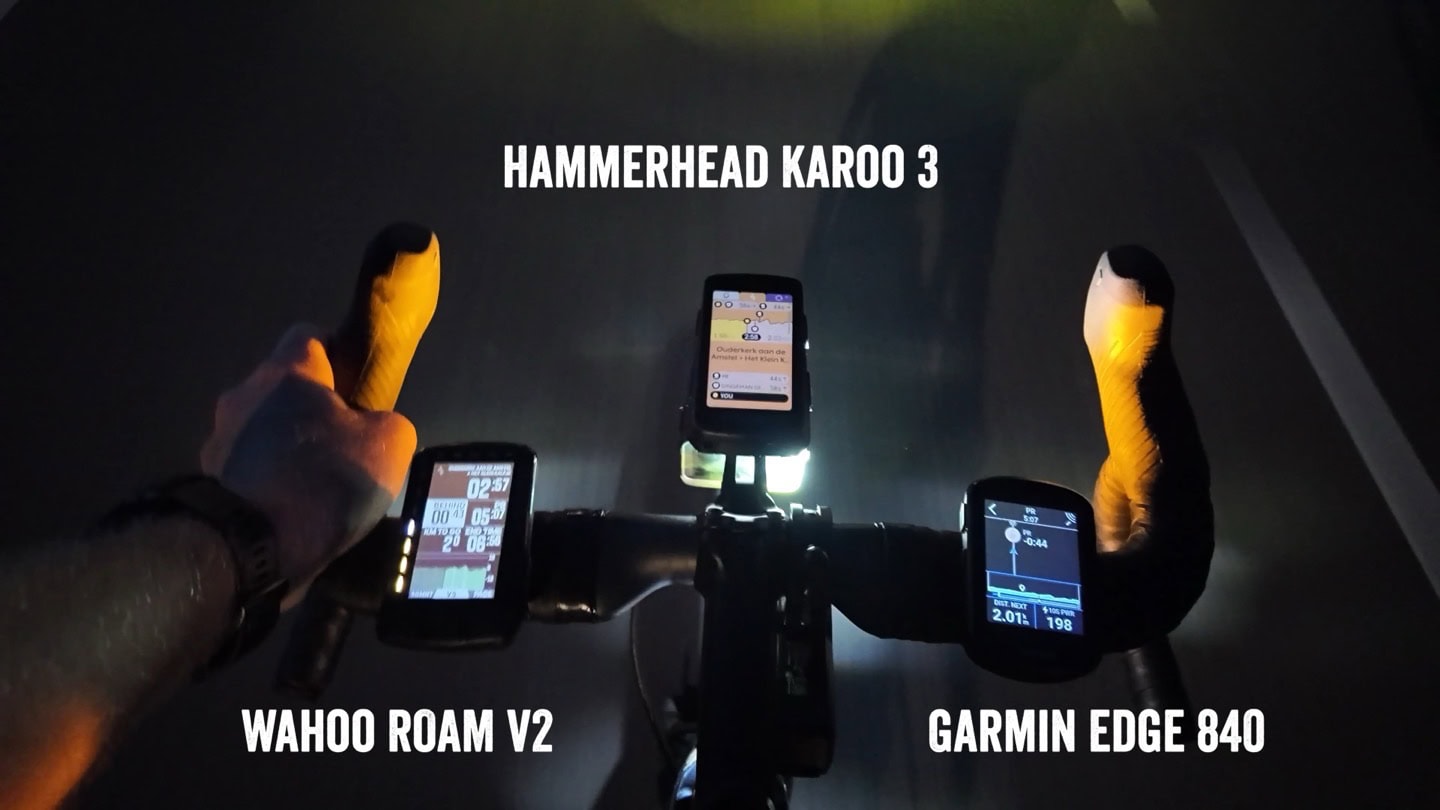
Inversely, in very bright conditions (direct summer sun), the Garmin & Wahoo units do better, especially slightly off-axis (where you normally ride). As a really simple example of this, check out these two photos side by side. One is directly looking down, and the other is at the same angle as a rider (both in bright direct sun). You’ll notice it’s harder to read the Karoo 3 in this scenario. Some of that challenge is simply camera optics, and some is real life. Again, all are perfectly viewable to my eyes. But the Garmin & Wahoo screens are more clear in direct sun, full stop. That said, I do find the Karoo mapping page more clear/readable than Garmin’s, but more on that down below in the navigation section. Note the slight differences both at an angle (how’d you’d be set back while riding), versus directly straight down (in the video I show this entire range in motion):

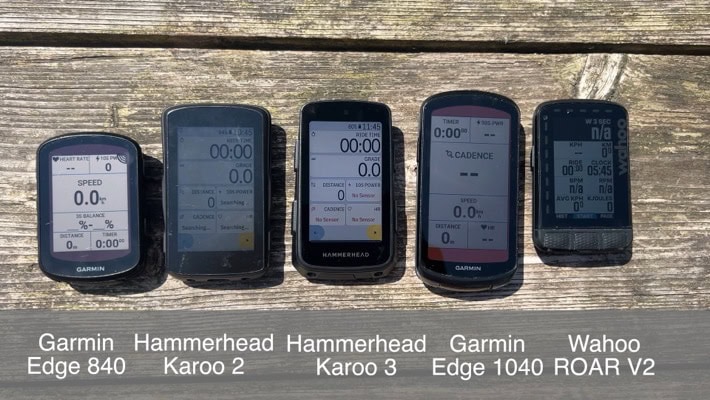
Lastly, what about touchscreens? Well, Wahoo has no touchscreen, so that removes that piece. All three units have buttons for controlling functions, and all three units support using Shimano & SRAM extra/bonus buttons for controlling the data pages too (well, SRAM says Garmin will very shortly anyway). In terms of rain usage, I’ve published videos of both the Hammerhead Karoo 3 and Garmin Edge 840 in direct/hard thunderstorm rain conditions, without any issues.
Note that both Garmin & Hammerhead made improvements here over previous models. Thus, if you’ve got a Karoo 2, then the Karoo 3 is very different here. And likewise, if you’ve got a Garmin Edge 830, the Edge 840 is different here too. That said, the Hammerhead Karoo 3 is still laggy in certain areas (namely dropping down from the menu), another area I show clearly in the video side-by-side with other units.
TLDR: Most people are going to overthink this section (perhaps even me). Seriously, all three units are perfectly fine, with the differences being relatively minimal, and only really notable when you have all three units side-by-side.
Usability & Easy of use:
Generally speaking, the easier something is to use, the less features it has. The more features something gets, the more complex it gets. Companies can mitigate or hide this to an extent, but eventually all companies that want to add more and more features battle with this.
Obviously, Garmin has the most features. Both Wahoo & Hammerhead will tell you that straight up. Inversely, they argue that by having less features, their own products are easier to use. In some ways, that’s true, and in other ways it’s just marketing speak. Anytime you switch from one brand to another, there’s a learning curve. I think all there companies products are easy to use at a basic level. At the same time, I think as you try and do more complex things on a Garmin device, it tends to be more complex to find some of those features. But the key is: Those options actually exist, whereas they don’t elsewhere.
From a simplicity standpoint, I’d agree Wahoo is probably “the easiest” overall to use, in that it has the least options/features. I think that was a big strategic benefit for them 5-7 years ago, but I’m not as convinced now. Hammerhead is also equally easy to use, and will feel much more like using your phone or apps on your phone.

The key difference I’d say is that with Hammerhead, the majority of your not-riding interactions are going to be with your Karoo, rather than with your phone or web/desktop app. Whereas with Garmin/Wahoo, they’ve got deeper apps to configure your bike computer, look at rides, and more.
And I know that users that have switched ecosystems (perhaps years ago), will have varied feelings here. But the market seems pretty clear here that “ease of use” hasn’t really been a barrier to consumers choosing one unit over another.
Data Pages & Data Field Options:
All three units offer a boatload of data fields, and I’ve never had any issues creating my standard-issue data pages that I use on all my bike computers. All three units also include TrainingPeaks fields like TSS/NP/IF. While I can find a list of Garmin’s Edge 840 data fields here, I can’t seem to find an online linkable list of Wahoo or Hammerhead’s data fields.
But again, it’s got pretty much anything you’d want covered. Likewise, when it comes to data pages and customization of data pages, all three offer a bunch of different options that probably have you covered. Garmin & Hammerhead tend to have a bit more on the graphical data field side, whereas Wahoo has their ‘dynamic’ data page concept, that allows you to increase/decrease the number of data fields shown on a page (during a ride), which also increases the size. You can set the importance of the data fields, such that if you only had one data field, it’d be X (e.g. power), but if you had two data fields it’d be power + heart rate, and so on.
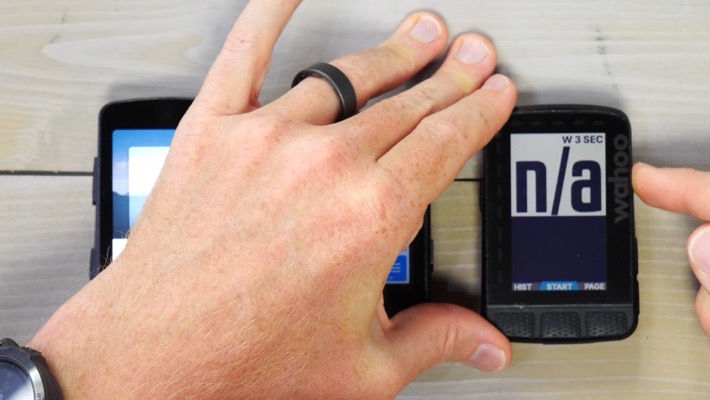
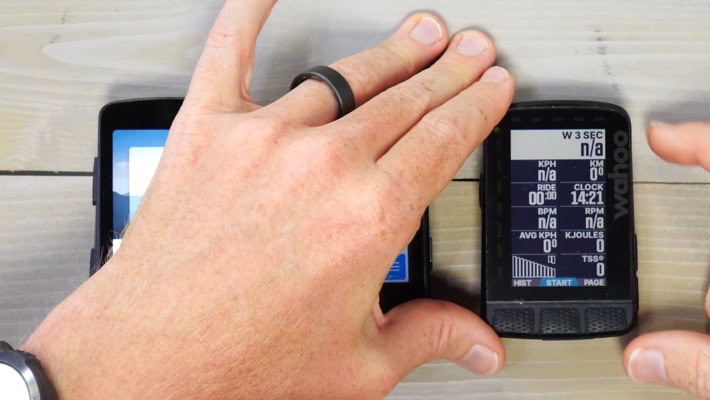
It’s a feature that some people really love, and others just shrug at. Inversely though, Wahoo lacks any sort of bike profile concept. Thus, you don’t have the ability to create different data pages/fields for mountain biking versus road cycling, etc… A gap many people find frustrating. Both Garmin & Hammerhead have ride profile concepts.
Lastly, as I’ll cover lower down in the 3rd party integrations, Garmin has a ton more data field/page options via Connect IQ, almost all of which are free.
Navigation & Mapping:
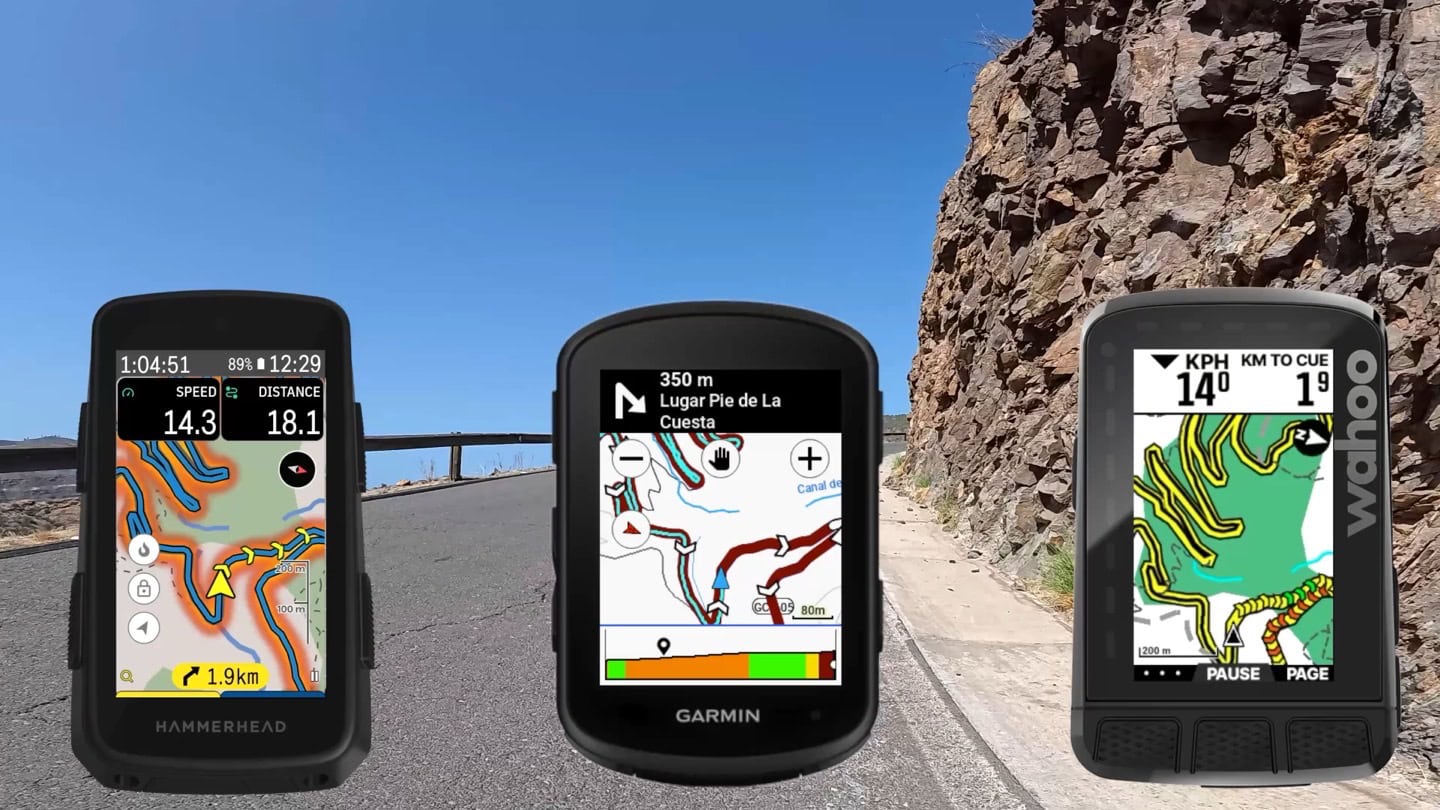
This is arguably the most complex of the categories. As there is no clear winner here. Instead, it’s variable depending on what exactly you value most. At a high level, all three have full and free mapping, with global free downloable maps (via WiFi). All three can receive routes from Strava and Komoot, along with other sources that vary slightly between them. You can create routes on both Hammerhead and Garmin web platforms, but Wahoo doesn’t have the ability to create a route within its app, except a point to point route (e.g. navigate to a specific point). All three can consume GPX/etc route files though.
All three will re-route on the fly, using real road data. So if you miss a turn, all three will find some place up ahead to get you back on course, or if required, tell you to turn around. In my testing, this works well across all three now. It takes years to get this right, and at this point they all do a good job of these, and do so virtually instantly.
The biggest difference you’ll see visually is actually just in the maps themselves. Here’s me routing along a road in the Canary Islands. You can see the three maps are set to as similar a zoom level as I could get (note the scale lengths are different). For me, the Hammerhead is the most visually pleasing, with the heat maps turned on. I can clearly see my route, as well as where others ride. The Wahoo is the most minimalist. And the Garmin is good, but the other data on the screen isn’t super useful.
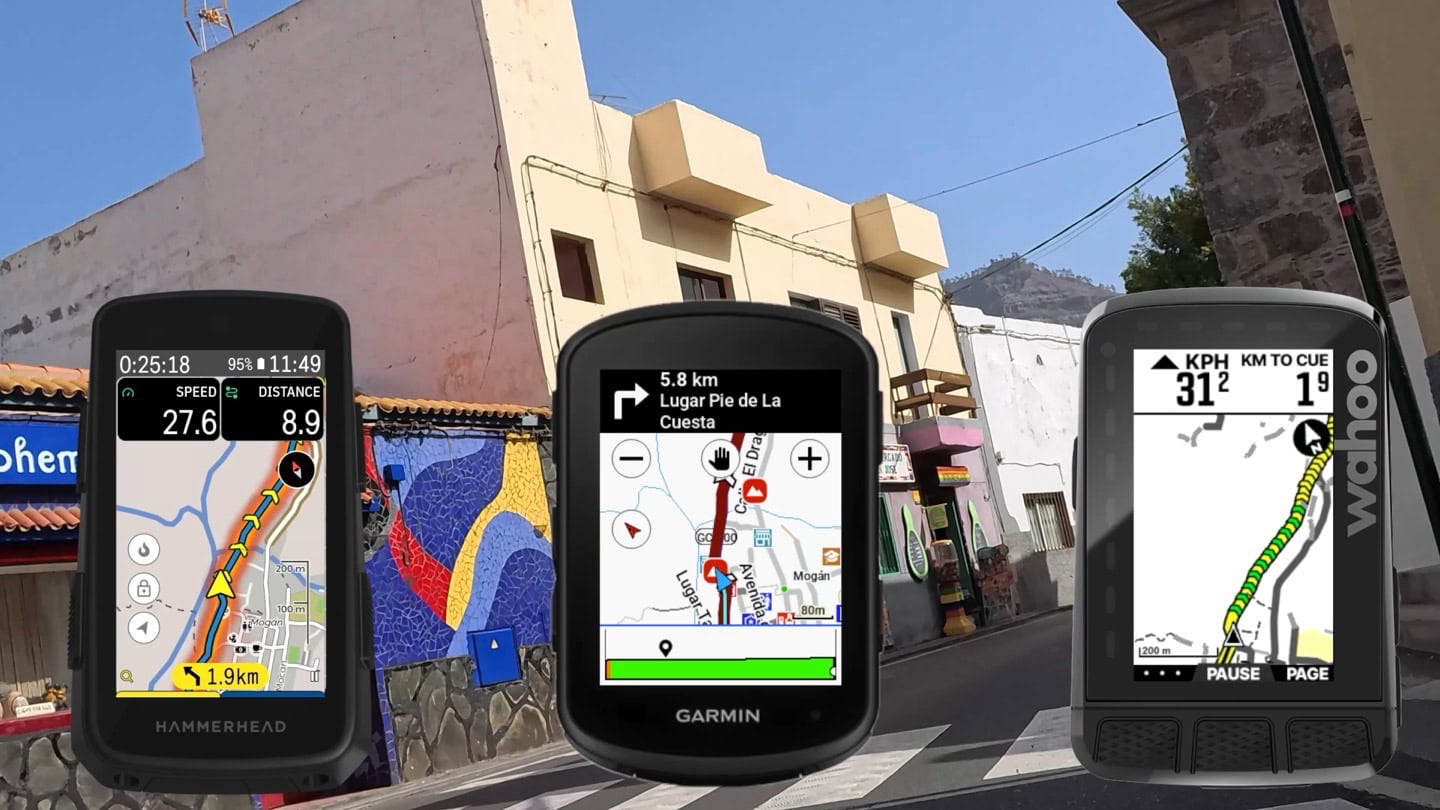
Again, I could write an entire post dissecting the differences here. I’ve navigated with all three just fine, but which style you prefer will probably be personal preference. Likewise, how each unit does turn alerts varies. Garmin does an initial full screen pop-over, Hammerhead has a swipe-up drawer, and Wahoo compresses things to make room for it. All of these act slightly differently depending on which data page you’re on at the time of the turn alert:
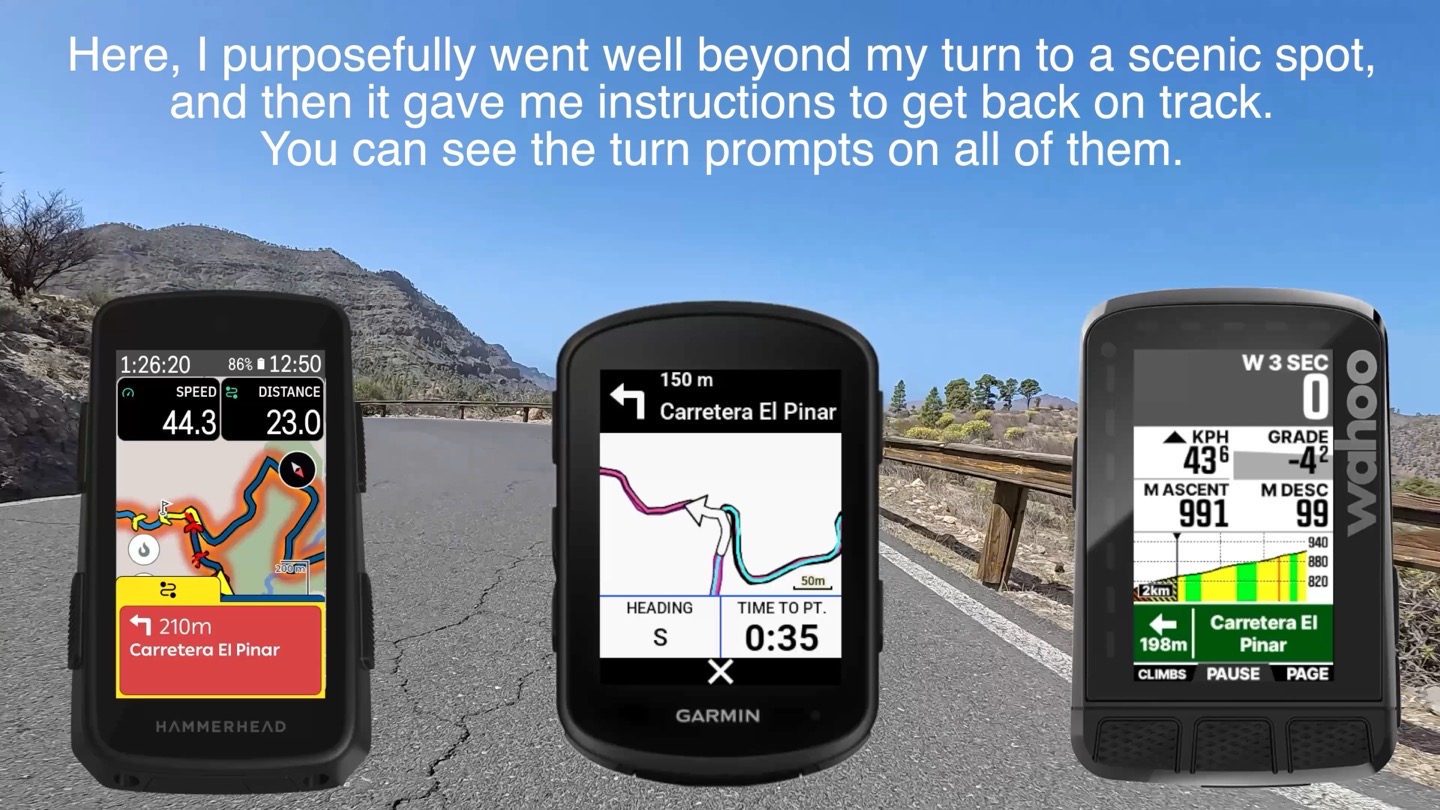
Beyond the map styles the units also have other map features. In Garmn’s case, they can generate on the fly round-trip routes from any location, using their own heat map data. So you can ask it for a 50KM route, and it’ll come back with a (generally quite good) ~50KM route. You can even specify which direction you want to ride (e.g. out to the west). Neither Wahoo or Hammerhead have this. Likewise, Garmin is the only one that displays points of interest and things like cafes on the map – and the only one that can route to a specific address without internet connectivity.
Yet inversely, both Hammerhead and Wahoo allow you to use your phone to send an address to the device. This means you can pick something from Google maps on your phone (usually far easier than trying to navigate a bike computer GPS address field), and then simply send directions directly to the Wahoo/Hammerhead devices. Quick and instant. Thus for navigating to a last-second new address, the Wahoo & Hammerhead tend to be easier.
In many ways, Garmin is the navigation and mapping behemoth here. It’s got as many features as an aircraft carrier, but isn’t quite as nimble as Hammerhead and Wahoo are for last second changes. If you’re just riding on routes from Strava or Komoot though, you’ll never really notice the differences outside of map styles.
Climbing:
All three units have a climbing-specific mode. Garmin was the first in this realm with ClimbPro, followed by Hammerhead and then Wahoo. In the original mode, all three companies required a route be loaded to get upcoming climb information. Then Hammerhead introduced their free-ride version, which will automatically detect climbs on the roads ahead of you. Garmin & Wahoo followed suit as well. Thus, all three now have roughly equal modes.
When it comes to the displayed data up ahead, all three are very similar. They detect upcoming climbs (with or without a route), and show the distance and climb data to the top. Here’s how all three look on a recent climb:
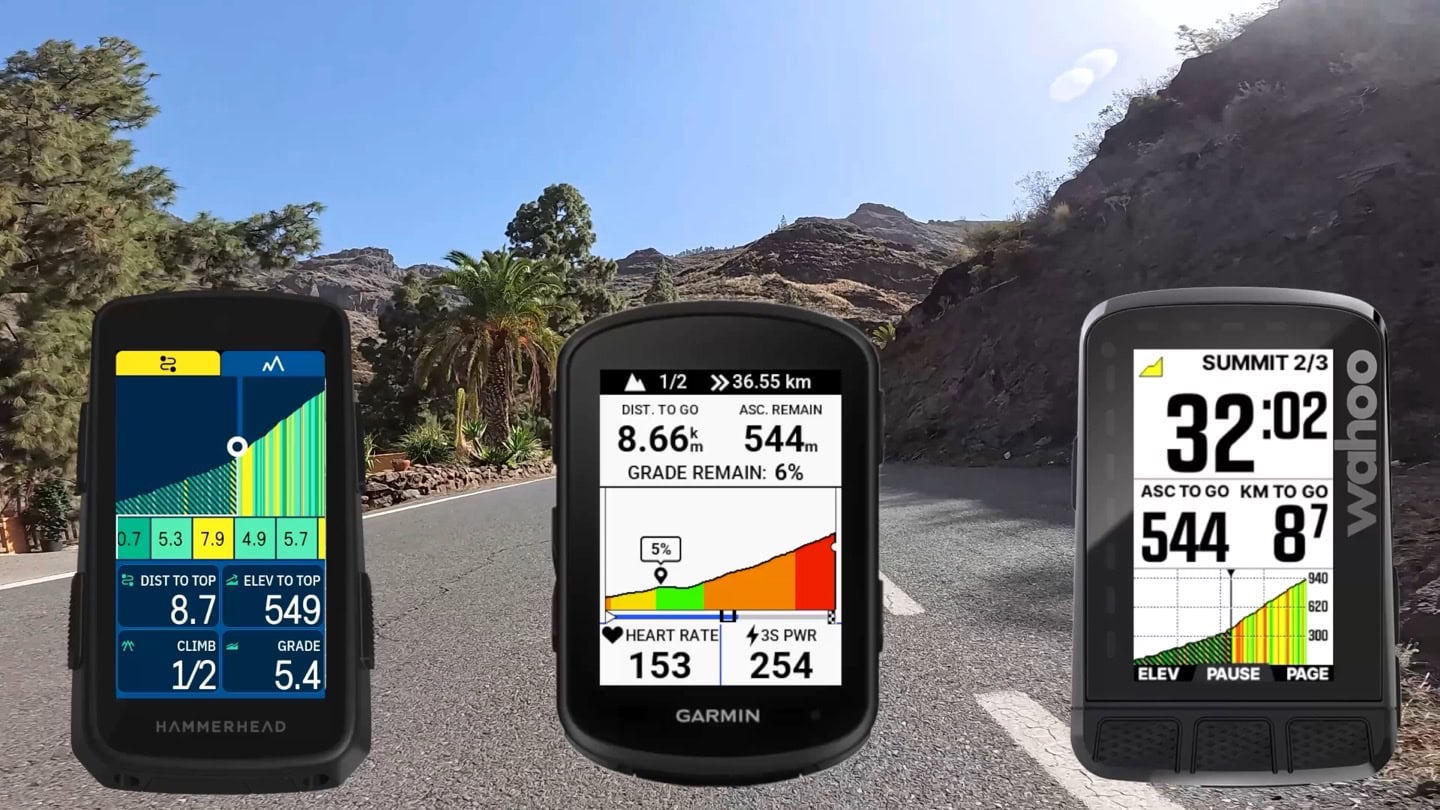
In testing all three across a variety of climbs (both recently, and long term), there are very minor little quirks based on detection of the climbs themselves. For example, each company has very slightly different definitions of climbs (length/grade), though despite that, almost all of the climbs I’ve ridden recently have been detected within a few seconds of each other.
In terms of the underlying climb data (gradient), Hammerhead made improvements for the European gradient data set this past spring, which has helped in my testing in terms of previous gradient accuracy issues they’ve had. That said, I do still get some wonky upcoming 15% gradients that don’t exist in real life. But it’s reduced enough now in my testing this past few months that I don’t consider it much of an impact anymore.
Structured Workouts:
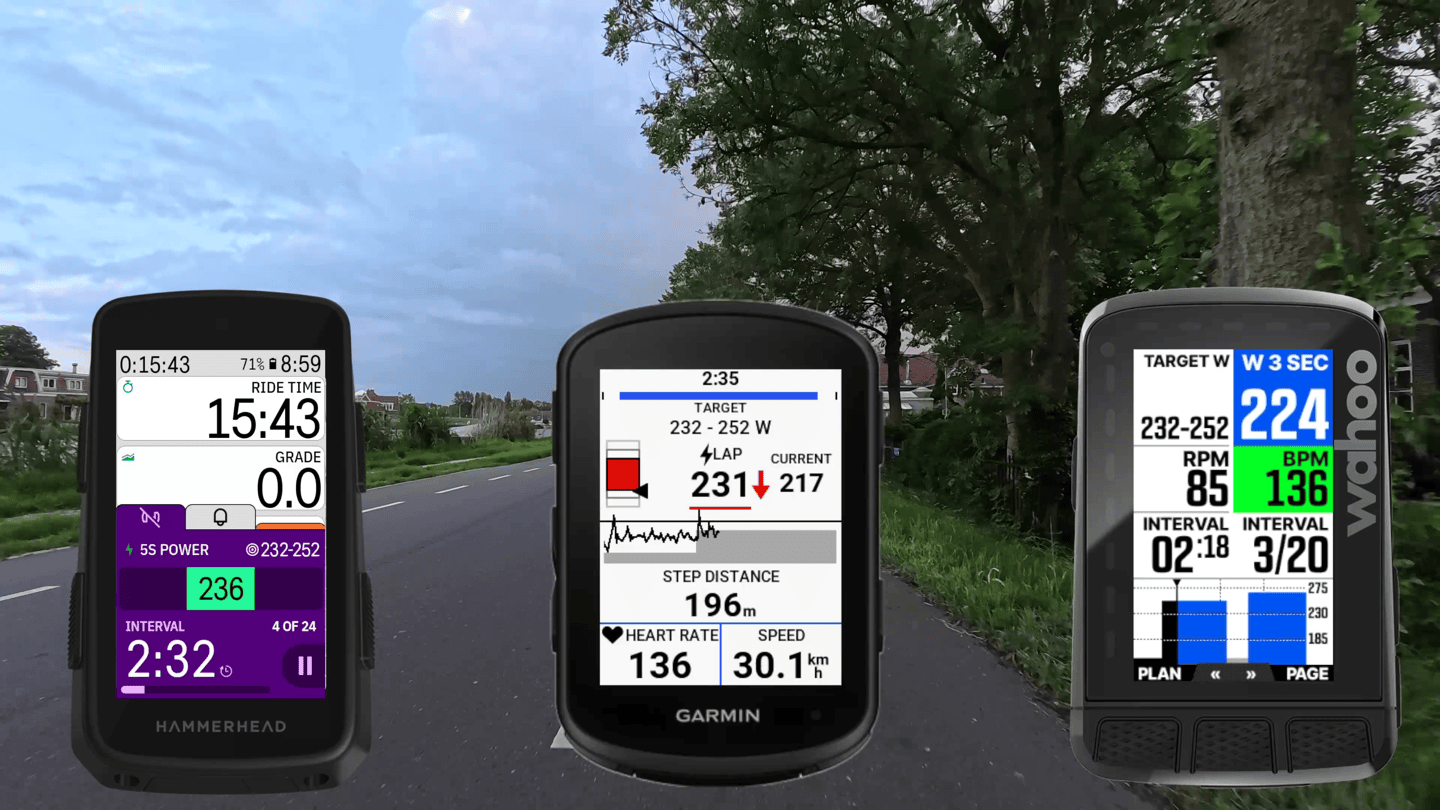
All three units support structured workouts, such as those coming from platforms like TrainingPeaks. To that end, there’s two core differences here:
A) Which platforms they support
B) What the in-ride experience is like using it
On the platform side, all three support TrainingPeaks & TrainerRoad. After that, Wahoo also supports their own SYSTM. And Hammerhead also supports Xert via the Xert app. Garmin supports basically every other platform (e.g. Final Surge, Athletics, etc..), as Garmin has a dedicated API that makes it easy for developers to quickly push workouts to all Garmin devices.
This allows you to have a structured workout both outdoors, as well as controlling an indoor smart trainer. All three units supports ANT+ FE-C trainers.
Next, is how good the implementation is. Both Garmin & Wahoo’s implementation are solid. Minor style differences between them, but nothing of major consequence. Hammerhead’s however wasn’t great, but has actually been improving over the last month. There’s still some progress to be made (such as some form of visual indication as to what’s coming up on a single page), but they’re slowly getting there.
Lastly, for lack of anywhere else to put it – Garmin does also have their ‘Power Guides’ feature. This is really aimed more at racing than structured training. It allows you to put in a specific goal for an event, load the course up, and it’ll give you exact power guidance throughout the route to have you hit your goal time. It’s basically a race plan, but can also be adjusted on the fly if things are going better/worse. I outline how this works in the Garmin Edge 840 in-depth review.
Strava Live Segments:
All three units support Strava Live Segments, albeit to somewhat different degrees. In this case, the Hammerhead and Wahoo implementations surpass that of Garmin, because they can track multiple overlapping segments at once. That’s handy if you’re on a route that has perhaps a shorter segment and a longer segment. With the Garmin, you’ll only see the first segment, but with Hammerhead and Wahoo, you’ll see both segments and can easily toggle between them.
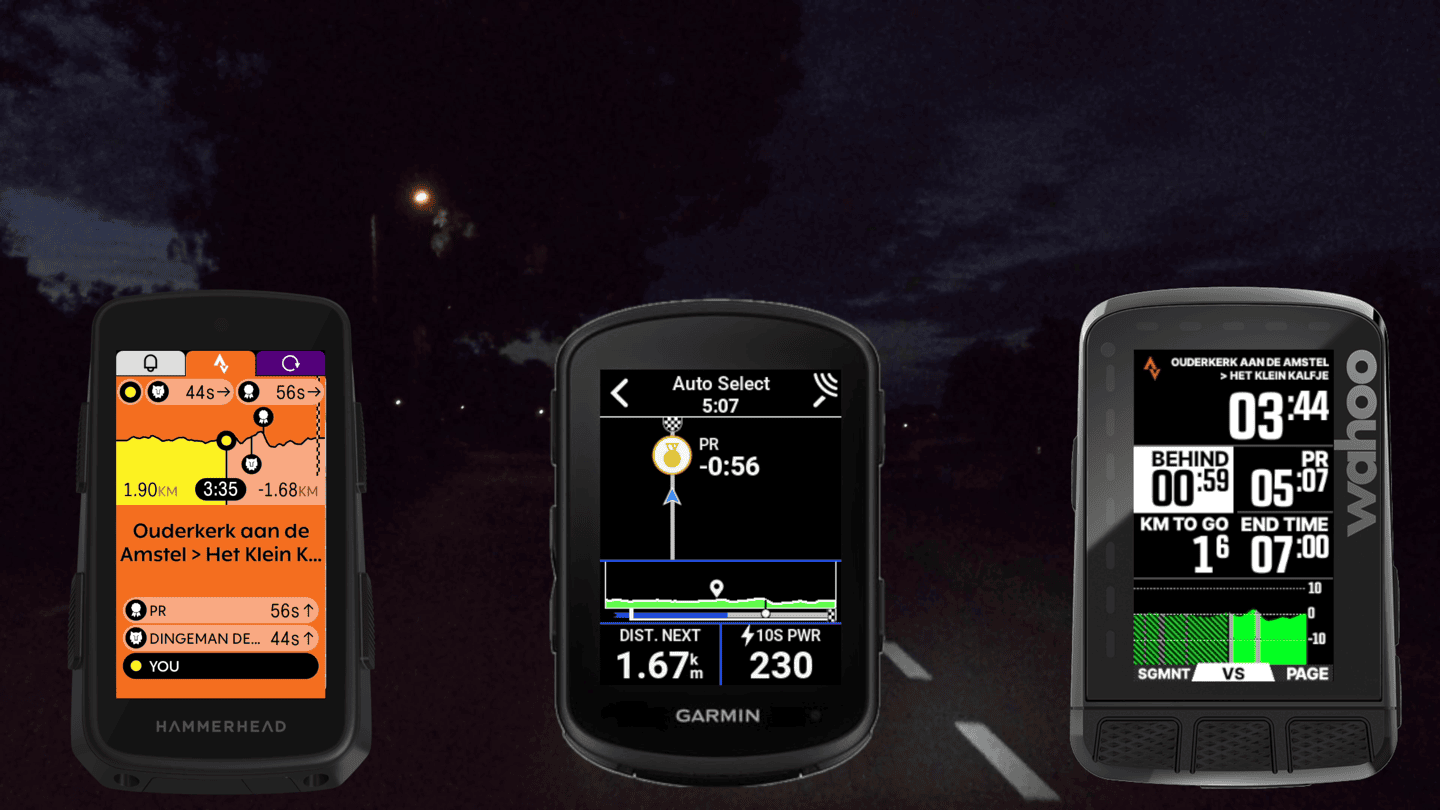
Outside of that, I’d argue that Hammerhead does a much better job at visualizing your ‘competitors’ on the screen. Meaning you can see exactly where the people are head of you on a little timeline, versus just knowing how many seconds they are.
Note that displaying Strava Live Segments requires a paid Strava subscription, per Strava requirements. That said, Garmin does have their own Segments (relics of days long past) that you can create for free and compete on. Most people aren’t really competing on these against other Garmin users, but rather, instead of paying for Strava they just build some of their favorite segments in Garmin Connect, and race on them for time purposes. Once uploaded to Strava (even with a free account), they’ll still end up on the leaderboard.
Also note that all three devices let you disable Strava Live Segments, if that’s not your jam.
Training Load & Physiological Metrics:

This is another easy category, as Wahoo & Hammerhead have none. Whereas Garmin does have training load and a slate of other training load focused metrics. This includes things like Acute Training load, Recovery Time, VO2Max, Training Focus, and more.
Further, only Garmin has suggested workouts, and included training plans for various events. You can give it an event (e.g. a Grand Fondo), and it’ll create a custom training plan for it, leveraging your power meter. Likewise, you can also tell it nothing, and it’ll just keep you busy with varied workouts based on your detected training level. In my experience, these workouts tend to be pretty solid (again, if you have a power meter.
But beyond that, it also includes crash detection (I suppose the opposite of training load), which will notify friends/family if you’ve crashed. If that happens it’ll send them a notice as well as your current location using the GPS.
Battery Life:
Aside from display tech, battery life is easily the biggest difference between these units. And for some, it’s going to be the defining factor. Let’s look at the (claimed/official) specs first for GPS time, then reality:
Hammerhead Karoo 3: “At least 15 hours”
Garmin Edge 840: Up to 42 hours (28hrs in multi-band)
Garmin Edge 840 Solar: Up to 60 hours
Wahoo ROAM V2: Up to 17 hours
I noted the solar edition this time, because if you live in a very sunny place, then that can make a bit of difference. But it does take a fair bit of sun. Still, if you’re riding a long time, and have your settings turned down – it can really add up.
Additionally of note, is that Garmin is the only company that offers a detachable waterproof battery pack for on-the-go charging, as well as charging via another product, the ‘power mount’ for bikes that have built-in charging ports. All three companies can charge via USB-C cable (while riding), if you’re looking to charge in the rain, only Garmin has that capability.
That said, most of us aren’t. So more day to day battery life is what matters. Here’s a chart I did two weeks ago on a 3.5hr ride, showing the battery burn between the three units. In this case, the Edge 840 Solar on a sunny day. All three units were roughly in the same pages/settings, and none had screen recording turned on. All three were in multiband configurations, with all three connected to the same sensors (HR/shifting/power), the Edge also was connected to the NIX hydration & CORE body temp sensors.
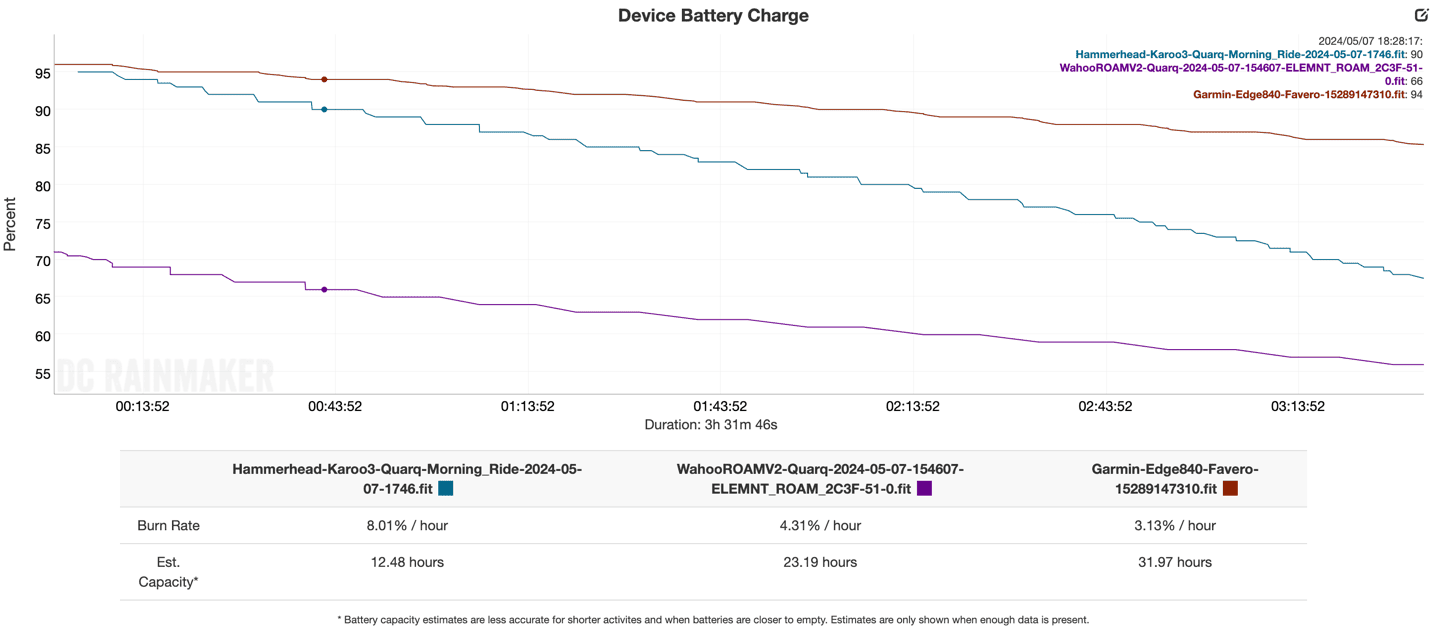
As you can see, real-life usage will vary based on the day and exact settings (especially the backlight). I’ve got some rides over the past month where the Edge reports less, and the Wahoo more. And vice versa. The Hammerhead Karoo 3 on most of my rides though has been trending pretty constantly towards about 12-13hrs in battery usage.
Sensor Connectivity:

All three of these units support all of the major open-standard ANT+ & Bluetooth sensor types you’d expect from any bike computer, which includes:
– ANT+ & Bluetooth Smart power meters
– ANT+ & Bluetooth Smart heart rate sensors
– ANT+ & Bluetooth Smart speed & cadence sensors
– ANT+ Gear Shifting
– ANT+ Bike Lights
– ANT+ Bike Radar
– ANT+ LEV eBikes
– ANT+ FE-C Trainers
– CORE Body Temp Sensor
– Tire Pressure Sensors
Of course, the big ticket one for Shimano users is the lack of Shimano Di2 support from Hammerhead, after Shimano got upset and forced SRAM to remove it. I detail that here. You can though use a 3rd party plug-in, Ki2, to get around that. Albeit, it’s not yet available/updated for the Karoo 3 (but is coming shortly).
Now once you get beyond the above sensor types, there’s an absolute boatload of specialty sensors that are really only supported on Garmin, via Connect IQ. We’re likely talking stuff like aero sensors, hydration sensors, muscle oxygenation sensors, etc…. In addition, there’s also just a lot of other sensors that are supported on Garmin natively/built-in, that aren’t supported on the other two, including Garmin VIRB action camera support. But Wahoo does have one unique sensor capability: They can control their own Headwind fans, and soon GoPro cameras too.
In other words, for most cyclists, you’ll be more than fine on any of the three for all major sensor types. But if you’ve got a fancy aero sensor or something else, you’ll probably only be able to connect to it on the Garmin Edge.
Web Platform & Phone Apps:
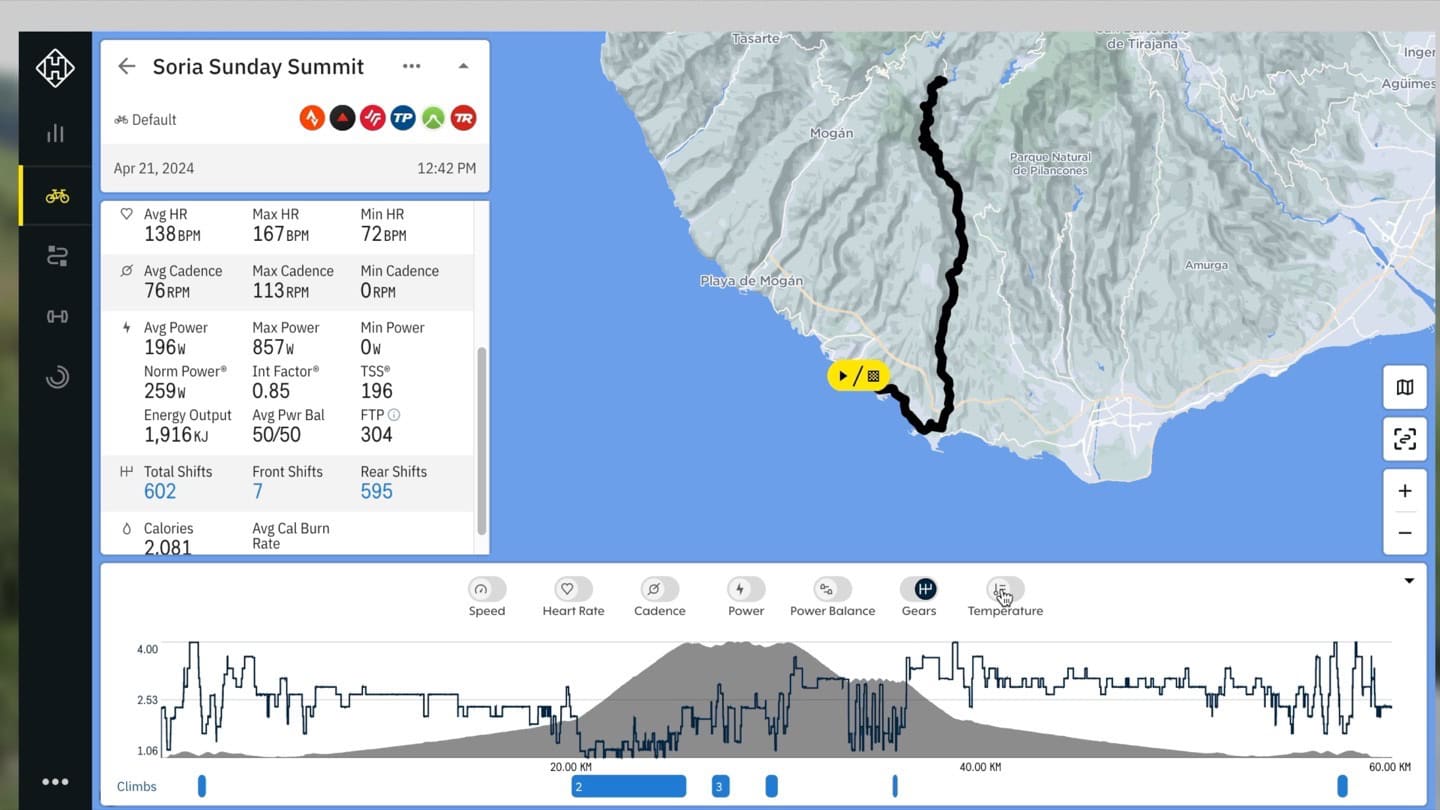
This category looks at both the smartphone apps and websites that each unit has. Garmin easily wins this category by a landslide. Still, both Hammerhead and Wahoo do offer some basic functionality that covers most peoples core needs. Here’s what each has:
Garmin: Deep web platform and mobile apps with analytics, connectivity, planning tools, device configuration, etc…
Hammerhead: Basic web platform with good route planning tools, and basic post-ride analytics. Mobile app to simply provide sync capabilities to Karoo 3.
Wahoo: A reasonable smartphone app for basic analytics, but plenty of device configuration options from the smartphone app. No user-facing web platform.
I could dive into all three of these for an entire post, but alas, I do that in each of my reviews. The key thing here to understand is a bit of a different philosophy between each of them.
At one end you’ve had Garmin which is providing ‘everything’ you could possibly need to interact with the device, and tons of depth for analytics/reports etc… With the Garmin approach, there’s no need for a casual user to use 3rd party apps/platforms for anything (of course, you still can). At the opposite end of things was Wahoo initially, which aimed to really just focus on “the device” and then offload other elements (analytics/etc) to 3rd party apps. Over time though they’ve added more features to their app, so it covers the basics. Hammerhead has had basically no app till now, and even now, it’s just a conduit of internet to the Karoo 3 – you can’t do anything with the app. However, their web platform has been quite good for route creation/importing, allowing the majority of things people want to do. There’s also basic individual ride summary data there (but no long-term/multi-month ride analytics/etc).
3rd Party Integration & Apps:
This category is basically broken out into two core pieces: On-device 3rd party apps, and platform 3rd party integrations.
Let’s go with the easiest one first – platform 3rd party integrations. This is things like Strava or TrainingPeaks connectivity, or Komoot uploads/etc… All three platforms have all of the ‘majors’ in this regard. However, Wahoo has even more connectivity than Hammerhead (partners like Relive, Final Surge, 2Peak, and more), and Garmin has infinitely more 3rd party platforms it connects with. We’re talking many many hundreds, compared to Hammerhead’s sub-10, and Wahoo’s 20-30. Are you on those other platforms? Probably not…but then again, maybe.
The next piece is on-device integrations/apps. Both Wahoo & Hammerhead have a handful of ones each, such as Xert for Hammerhead and Best Bike Split for Wahoo. But that’s in comparison to the literally thousands of apps you can download for the Garmin Edge. Most of these apps are custom data fields displaying unique data (like a live wind app or a radar data recording app), or integrations with larger apps/devices/sensors.
While Hammerhead does have the ability to side load 3rd party apps, it’s currently a complicated and technical process that most non-geeks would be intimidated by. As such, there’s virtually no apps that are designed for it, outside of the Shimano Di2 plug-in app. And that one isn’t yet working on the Karoo 3 (as Hammerhead hasn’t released the Karoo 3 SDK yet).
Again though – as always, figure out what you’re actually going to use, or perhaps likely to use. The vast majority of people don’t use most of these integrations and simply upload to Strava/TrainingPeaks.
GPS & Elevation Accuracy:
This is a super-easy category. All of these are accurate, for both GPS & elevation. You can see this in my in-depth reviews, where I have dedicated sections for all of them. All three of them have multiband/dual-frequency GPS/GNSS, and all three of them are throwing down some very solid tracks. Here’s one snippet, from my much large accuracy test section, in the mountains:
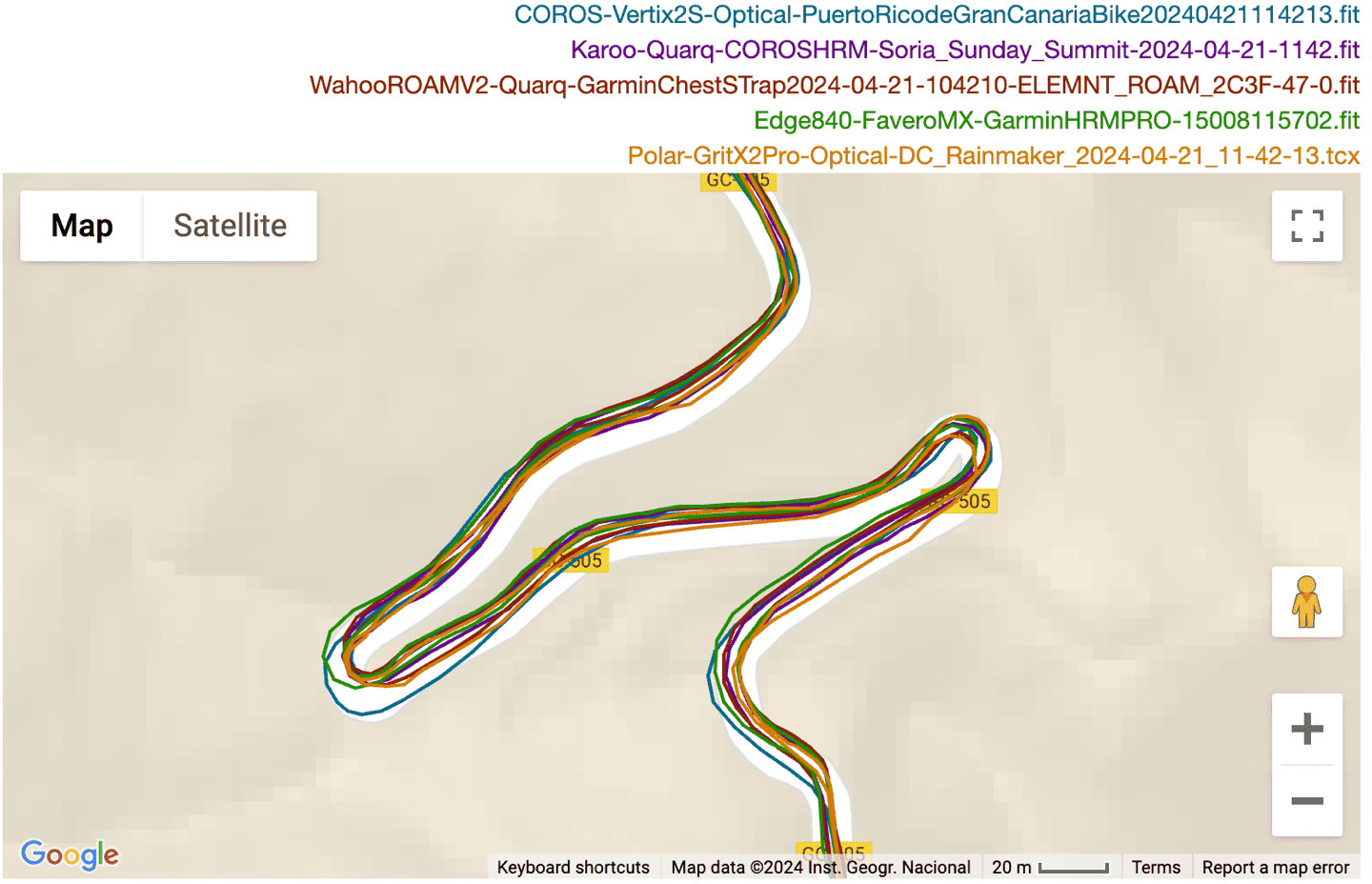
Again, this is the one category you can actually ignore here, and I almost didn’t bother to list it, but I figured I’d cover my bases nonetheless.
Wrap-Up:
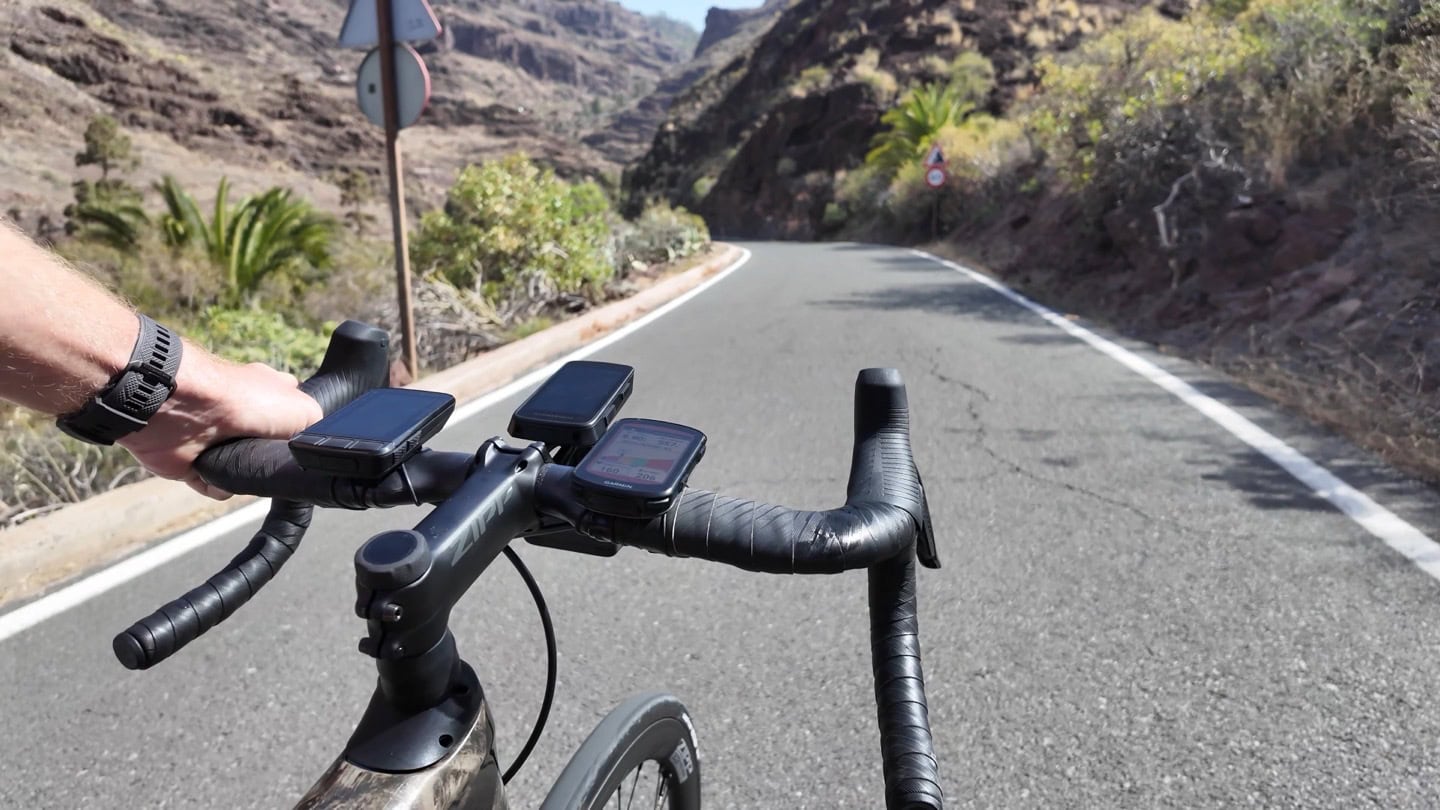
As I said at the beginning, all three units are great units. All three units will get you where you want to go, record all your cycling data, and display the most common cycling metrics. All three units have good enough battery for most people’s needs, and all three units will upload to the common cycling platforms that you know and love. And all three units will cost you roughly the same amount of cash.
The key differences here are more nuanced, and will vary quite a bit based on how you value certain features. Broadly speaking, nobody disagrees that Garmin has the most features/functions – be it on the device itself, the phone, or the website. Instead, the discussion is whether you’ll use those extra features, and the ease of use of said features. Most are easy to use, but finding them can be like finding buried treasure. Still, there are specific areas where the Wahoo & Hammerhead units outshine Garmin. For example, Hammerhead’s Strava Live Segments implementation is better, and I’d argue the map legibility/display (graphical choices) of the Hammerhead map is easier to understand too. Meanwhile, Wahoo’s ability to quickly download smaller per-country maps via WiFi is super useful if you’re already traveling (versus the much larger Garmin maps).
But again, it all depends on what you want, and how you want to use it. Hopefully, between the 28,000 words above and the 24-minute video, I’ve covered as many differences as possible to help you make that informed choice. If not, there’s always the comments section.
With that – thanks for reading!
Found This Post Useful? Support The Site!
Hopefully you found this review useful. At the end of the day, I’m an athlete just like you looking for the most detail possible on a new purchase – so my review is written from the standpoint of how I used the device. The reviews generally take a lot of hours to put together, so it’s a fair bit of work (and labor of love). As you probably noticed by looking below, I also take time to answer all the questions posted in the comments – and there’s quite a bit of detail in there as well.
If you’re shopping for the Garmin Edge 840, Hammerhead Karoo 3 or Wahoo ELEMNT ROAM V2 or any other accessory items, please consider using the affiliate links below! As an Amazon Associate I earn from qualifying purchases. It doesn’t cost you anything extra, but your purchases help support this website a lot. Even more, if you shop with TPC (The Pro’s Closet), you’ll save $40 on purchases over $200 with coupon code DCRAIN40! The Pro’s Closet has been a long-time partner of the site here – including sponsoring videos like my cargo bike race, as well as just being an awesome Colorado-based company full of good humans. Check them out with the links below and the DCRAIN40 coupon!
And finally, here’s a handy list of accessories that work well with this unit (and some that I showed in the review). Given the unit pairs with ANT+ & Bluetooth Smart sensors, you can use just about anything though.
And of course – you can always sign-up to be a DCR Supporter! That gets you an ad-free DCR, access to the DCR Quarantine Corner video series packed with behind the scenes tidbits…and it also makes you awesome. And being awesome is what it’s all about!
Thanks for reading! And as always, feel free to post comments or questions in the comments section below, I’ll be happy to try and answer them as quickly as possible. And lastly, if you felt this review was useful – I always appreciate feedback in the comments below. Thanks!


